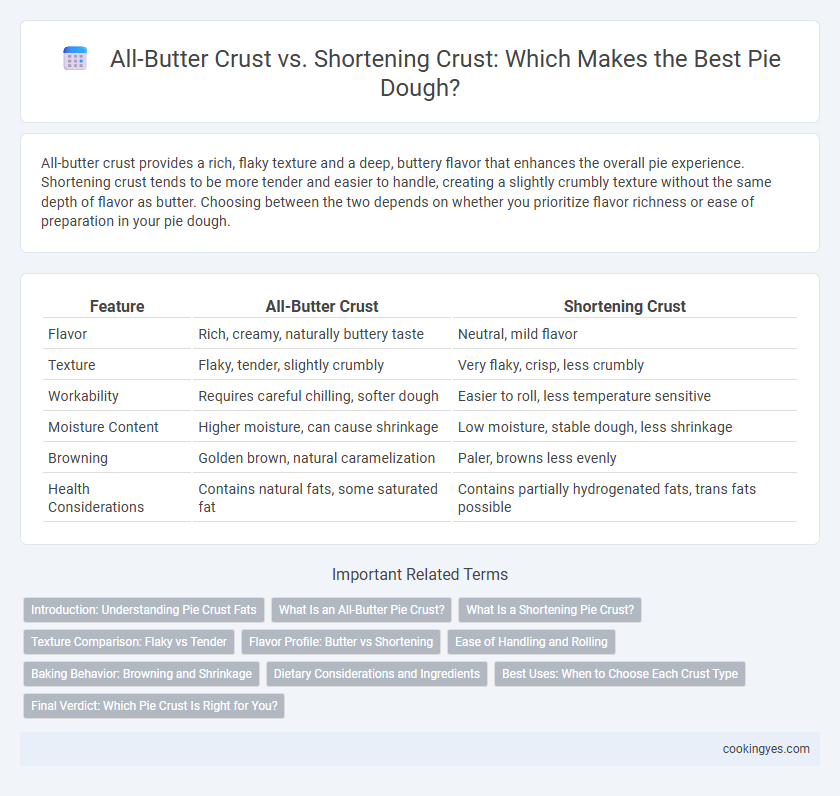All-butter crust provides a rich, flaky texture and a deep, buttery flavor that enhances the overall pie experience. Shortening crust tends to be more tender and easier to handle, creating a slightly crumbly texture without the same depth of flavor as butter. Choosing between the two depends on whether you prioritize flavor richness or ease of preparation in your pie dough.
Table of Comparison
| Feature | All-Butter Crust | Shortening Crust |
|---|---|---|
| Flavor | Rich, creamy, naturally buttery taste | Neutral, mild flavor |
| Texture | Flaky, tender, slightly crumbly | Very flaky, crisp, less crumbly |
| Workability | Requires careful chilling, softer dough | Easier to roll, less temperature sensitive |
| Moisture Content | Higher moisture, can cause shrinkage | Low moisture, stable dough, less shrinkage |
| Browning | Golden brown, natural caramelization | Paler, browns less evenly |
| Health Considerations | Contains natural fats, some saturated fat | Contains partially hydrogenated fats, trans fats possible |
Introduction: Understanding Pie Crust Fats
All-butter crusts offer rich flavor and flaky texture due to butter's water content creating steam during baking, while shortening crusts provide a tender, crumbly texture because shortening is 100% fat and melts evenly. Butter's milk solids contribute to browning and depth, whereas shortening creates a neutral taste and higher melting point, leading to easier handling. Choosing between all-butter and shortening crust depends on desired texture, flavor intensity, and ease of preparation in pie dough recipes.
What Is an All-Butter Pie Crust?
An all-butter pie crust is made exclusively with butter, resulting in a rich, flaky texture and distinct buttery flavor that enhances any pie. Its high water content helps create steam during baking, which contributes to a tender, layered crust. Unlike shortening crusts, all-butter crusts offer superior taste and a delicate crumb, though they require careful handling to prevent melting too quickly.
What Is a Shortening Pie Crust?
A shortening pie crust is made using solid vegetable shortening instead of butter, resulting in a tender and flaky texture due to shortening's high melting point and lack of water content. This type of crust tends to hold its shape better during baking and produces a softer, more pliable dough that is easier to work with. Unlike all-butter crusts, shortening crusts have less flavor but offer superior durability and a consistently light, flaky bite.
Texture Comparison: Flaky vs Tender
All-butter crusts yield a rich, flaky texture due to the butter's high water content creating steam during baking, which puffs up the dough layers. Shortening crusts produce a tender, crumbly texture because shortening lacks water and melts slower, preventing excessive gluten development. Choosing between all-butter or shortening crust depends on whether a flaky or tender pie dough texture is desired.
Flavor Profile: Butter vs Shortening
All-butter crusts deliver a rich, creamy flavor with a slightly sweet and nutty undertone due to the milk solids in the butter, enhancing the pie's overall taste. Shortening crusts have a more neutral flavor, allowing the filling to shine while providing a tender, flaky texture. Bakers who prioritize a buttery aroma and distinct taste often prefer all-butter crusts, whereas shortening crusts are favored for their consistent texture and subtle flavor.
Ease of Handling and Rolling
All-butter crust offers a tender texture but tends to be softer and stickier, making it more challenging to handle and roll without chilling. Shortening crust is firmer and less sticky, providing greater ease in rolling and shaping due to its higher melting point and lower moisture content. For bakers prioritizing ease of handling, shortening crusts reduce dough tearing and surface sticking, facilitating smoother rolling sessions.
Baking Behavior: Browning and Shrinkage
All-butter pie crusts brown more richly due to the milk solids in butter, creating a golden, flavorful finish, while shortening crusts tend to be paler and less flavorful. Butter-based doughs shrink more during baking because of their higher water content, affecting the final pie shape. Shortening crusts hold their form better with minimal shrinkage, offering a firmer texture ideal for intricate pie designs.
Dietary Considerations and Ingredients
All-butter crusts in pie dough provide rich flavor and natural ingredients but contain higher saturated fats and calories, affecting those with dietary restrictions on fat intake. Shortening crusts offer a neutral taste and tend to be lower in saturated fat, making them suitable for individuals seeking reduced cholesterol options or vegetarian-friendly fats, but they often include hydrogenated oils with trans fats. Choosing between all-butter and shortening crusts depends on balancing flavor preference with dietary needs such as fat content, cholesterol levels, and potential allergens.
Best Uses: When to Choose Each Crust Type
All-butter crusts deliver rich flavor and flaky texture ideal for delicate fruit pies and tarts where buttery taste enhances the filling, such as apple or cherry pies. Shortening crusts provide superior tenderness and higher melting points, making them perfect for savory pies or recipes requiring a sturdier crust that holds fillings like pot pies or quiches. Choosing between all-butter and shortening crust depends on desired flavor intensity and structural needs, with butter best for flavor-focused desserts and shortening favored for durability and ease of handling.
Final Verdict: Which Pie Crust Is Right for You?
All-butter crust offers rich, flaky layers and superior flavor, ideal for those valuing taste and texture in pies. Shortening crust provides a tender, crumbly texture with greater ease of handling and stability, perfect for beginners or savory pies. Choosing the right pie crust depends on whether buttery richness or ease of preparation aligns better with your baking needs.
All-butter crust vs shortening crust for pie dough Infographic

 cookingyes.com
cookingyes.com